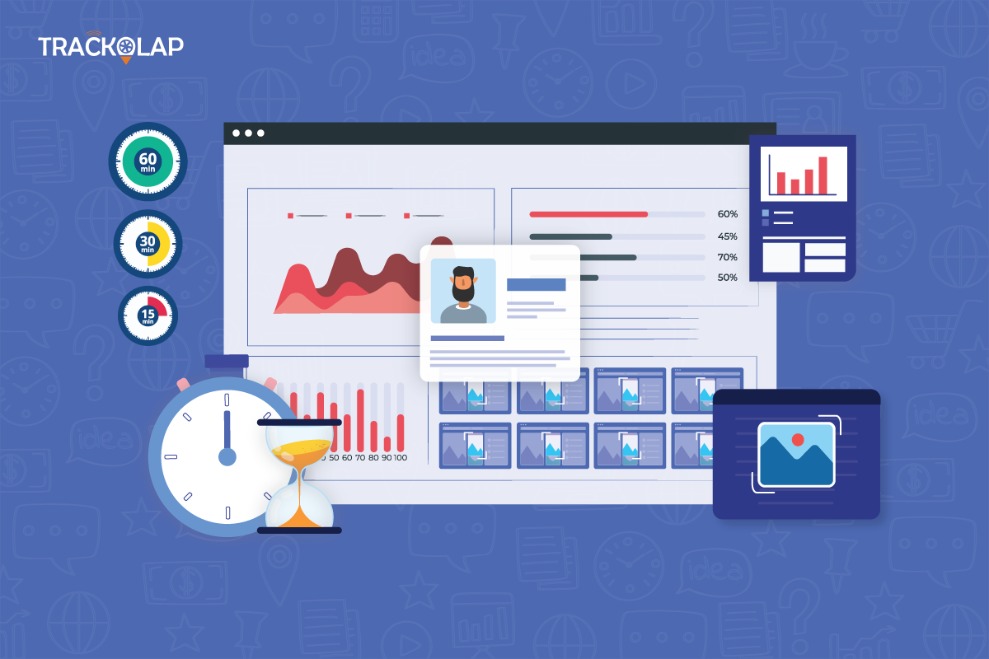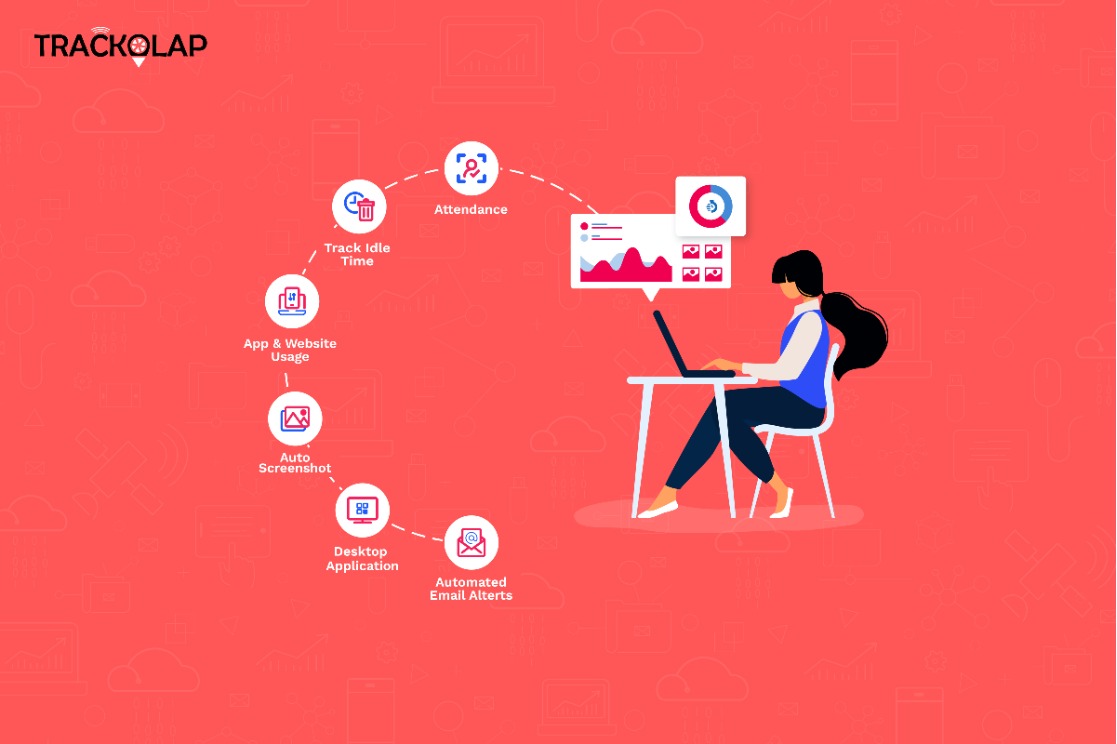
8 Employee Performance Metrics That You Must Track with TrackOlap
For HR professionals and managers, it is very important to maintain a consistent level of performance in the organization. They have to ensure that all the employees always maintain work quality, attendance, and other performance metrics.
However, in large and remote organizations, it is not easy to streamline an entire team's performance. Therefore, employee performance measurement tools are frequently used by organizations to build a consistent performance level.
Here TrackOlap is one of the leading employee performance measurement software today that can track and analyze multiple performance metrics for you. We offer a complete 360-degree view to management so they can track individual employee's or the entire team's performance in real-time.
So, if you wish to track your remote team's performance and ensure that each team member is offering the same level of performance, let's walk through this post.
What is Performance Metrics?
Performance metrics are measurable data used to track processes within a business using activities, employee behavior, and productivity as key metrics. This data is gathered to make sure that the company's objectives are fully met. The performance data is evaluated after comparing certain objectives with the real-time metrics.
Performance metrics are measured within the framework of your organization. For example, if you have the policy to address customer queries within 2 working days, this is a performance metric for you. If any of your employees failed to address customer's queries within 2 days, it would be considered as a poor performance.
Also, performance metrics are only useful if you track and analyze them in real-time. If you compare old data, it will not help you in streamlining your team's performance in the long run. Thus, you constantly need fresh and insightful data to measure the performance of your team.
8 Important Employee Performance Metrics
Today, you can monitor the performance of your employees in many ways. But the helpful performance metrics are which can provide you deeper insight into your employees' performance, but without offending them.
In the TrackOlap dashboard, we tried to include features that can help you detect the real-time performance of your individual employees, but without compromising their privacy in the way. The core performance metrics that you track with our dashboard are:
#1. Time Management Metrics
Time is a vital key performance measurement metric in all types of organizations. Whether you fail to meet project deadlines or your employees unnecessarily delay deliveries, time management metrics will help you manage all.
On the same lines, if you have given unreasonable deadlines to your employees, this will lead to burnout. Therefore, it is essential to measure time metrics closely so you can assign reasonable timelines to your employees. Also, you can weed out workers who are intentionally not following the deadlines with this metric.
For time management, we offer an automated timesheet feature that lets you analyze minute activities of your employees, such as:
- When do they take a break?
- When did they start their workday?
- How many leaves employees took?
- How many hours does an employee work daily? Etc.
#2. Work Quality Metrics
This is another important metric that every organization should consider. Poor work quality can lead to loss of clients, products, and business reputation.
So, it is crucial to make sure that your employees are adhering to high-quality standards. To do so, managers have to keep an eye on customer feedback, quality assessment reports, outbound sales calls, etc.
For example, through TrackOlap employee efficiency software, you can check the number of calls made by an employee in a day. This data can be further compared to the number of customers scored by the employee. You can determine how many calls a sales rep had made to score a client with these metrics. This way, you can check the performance of your sales team.
#3. Productivity Metrics
Productivity metrics are a balance between your employees' time management skills and work quality. Also, your team's productivity is directly aligned to the growth of your organization.
Therefore, we have amalgamated the time management and work quality assessment features in the tool. This will allow businesses to drill both time and work quality capabilities to their team.
Here, the application/website usage and tracking feature often help businesses maintain team productivity, especially in remote work environments. This feature silently works in the background, tracks employee time on applications or websites, and shares real-time data with you.
This way, you can make sure that your employees are using only work-related websites or applications. And, if you find an employee wasting time on social media platforms and spending less time on assigned work, you can warn that person.
Similarly, regular productivity reporting allows managers to analyze the increase or decrease in the person's productivity. Further, they can help employees to boost their productivity using first-hand data.
#4. Problem Solving Metrics
Problem-solving ability is something that every team member should possess. Especially today, while working remotely, an employee must be self-sufficient to handle basic problems on his own as they can't run to managers for every small problem.
Additionally, when your employees can solve problems, you can dedicate your time to expanding your business and other important things.
However, problem-solving isn't an easy skill and requires constant monitoring and analysis. So, keep an eye on your employees constantly and give them free reins to solve problems.
#5. Attendance Metrics
Attendance metric is part of time management but is also vital on its own. Through attendance metrics, you can analyze the motivation and engagement of employees in your organization.
Often employees with low engagement levels miss work a lot. The low-motivated employees' behavior manifests late arrivals, early departures, long lunch breaks, etc.
To analyze attendance metrics, we have embedded an automatic attendance system in the software. Employees can punch in and out with just one click. Also, they can use the break button to stop while taking breaks.
All in all, you can foster your team's full potential by ensuring that they are punctual. Plus, it helps you understand why certain employees have low attendance rates in your organization.
#6. Overtime Metrics
Employee performance metrics don't only involve attendance. It also involves the willingness of your staff to spend extra time to complete a project.
The overtime metrics help you understand how much your employees are dedicated to complete a project on time. It also shows how much your team honors your company's reputation.
So, do check whether your team is willing to work overtime if you require it. And, if overtime rates are low in your organization, try to find the reason behind it. For example, often, employees don't work overtime because they won't get adequate remuneration in return. But reasons can vary, so make sure to analyze your organization's attendance metrics.
#7. Communication Metrics
Clear and direct communication is the key to success. Therefore, you should review your team's communication skills, including how they communicate with coworkers, clients, vendors, etc.
If your team lacks clear communication, it can create chaos in your organization. So, you need to build a clear communication channel to foster healthy relationships in the organization.
For instance, using TrackOlap, you can assign projects, deadlines and share other relevant information with your employees. This, in return, makes it clear to the employees how and when you want work to be done.
Here a clear command of communication is established between employees and employers. This will facilitate momentum in your organization to harness smooth integration and workflow.
#8. Training Metrics
How many employees are willing to grow and learn for your organization? These metrics are something that not many organizations consider, which is a big-time mistake.
That's because if your employees aren't willing to invest their time to grow and learn new skills to be better in their job, this shows their low productivity. It shows a lack of innovation and zeal to be better workers.
Today, you can't simply grow with a good employee, no you need an employee who can step up with the change and expand his knowledge with time.
So, make sure to check how many hours your team spends on self-improvement and evaluation weekly.
Set your own Business Metrics
Well, above, we have discussed all the vital metrics that every organization should follow today. However, to define your organization's performance metrics, you have to closely look at your company policies, ideologies, and objectives.
You should select performance metrics that can help your organization grow and also empower your employees. So, managers, ponder hard before selecting performance metrics because your organization's success depends on it.
Once you have selected your performance metrics, give the TrackOlap team a call so we can help you better analyze your business's success metrics.






























 Back to Blogs
Back to Blogs










 D-5 Sector-59, Noida, Uttar Pradesh (India)
D-5 Sector-59, Noida, Uttar Pradesh (India) contactus@trackolap.com
contactus@trackolap.com 7011494501
7011494501










